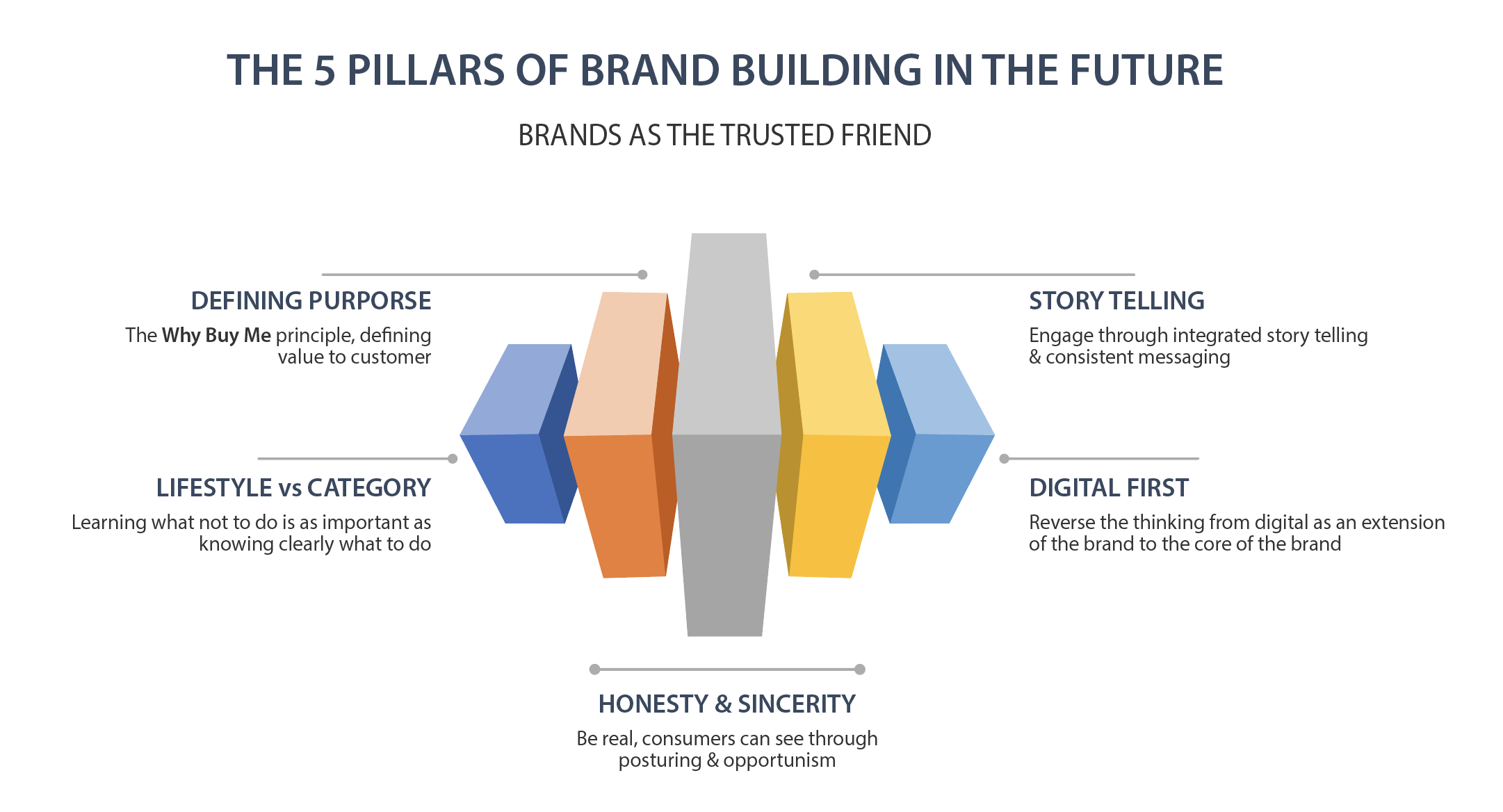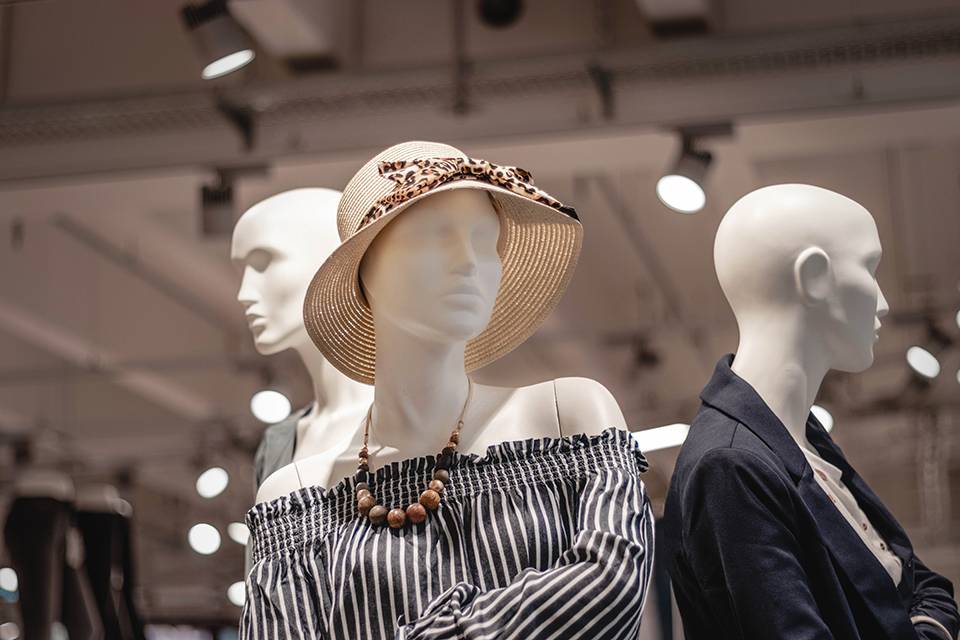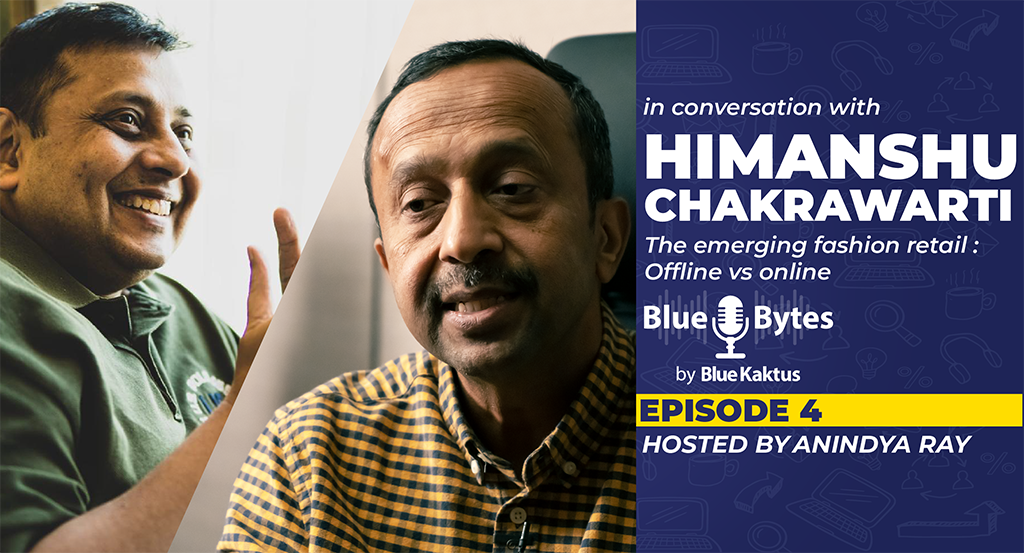THE FUTURE SERIES
Article 2 of 6
The Future of Fashion Marketing
This is the 2nd article in the Future Series. In the previous article we discussed the changing consumer behaviour and how it’s impacting the industry. In this article I want to talk about what this means for fashion companies.
For the purpose of this article, Brands refers to both retail brands and fashion brands.
The one major takeaway we get from this fast changing consumer behaviour is that brands need to reassess their relevance to their consumers as seen here. In the 80’s, 90’s and the early 2000’s which I refer to as the golden era of fashion brands, the brand made the person. Now in this newly established status quo, the brand is trying to fit into the life of the person. Peoples lives have become larger.
When I look at the Indian market today, it looks like a deluge of opportunism as opposed to well thought through positioning of brands.

Defining Purpose
This means establishing clearly, the purpose of the brand, why does it need to exist and what is it doing for the consumer.
This is what I call the ‘Why buy me’ principle. For e.g. in the Indian domestic market we have a plethora of mass value fashion brands/retailers, (not taking names, referring to all of them without any exception) but what exactly is their purpose? Except that ‘we sell cheap clothes/fashion’.
Whereas when seen in the International context, a Uniqlo, Zara, H&M have clearly defined what they mean to the consumer. Unique value added products at low prices, quick adoption of fashion from the ramp to the masses, mass production of trendy fashion - very clear positioning.
To be relevant in the long run, grow exponentially and leave a clear niche in the consumer psyche, brands need to clearly differentiate and position themselves and this is even more relevant in todays noisy landscape.
Now let’s move to another very interesting facet of fashion brands, the obsession with becoming lifestyle brands.

Lifestyle vs. Category
Brands no more dictate lifestyle choices, consumers absorb them from different social media sources. Influencers are a ‘thing’ today, peddling lifestyles to all. Rarely do we come across some one who buys a complete ensemble of a mannequin, or pick up everything from the same store for decorating the house. Mostly, we mix and match.
While brands offer a complete lifestyle to establish a ‘lifestyle approach’ - their sales mix is usually dominated by one category. Some of the most iconic brands are category based/predominant brands for e.g. Levis.
With online shopping becoming a more dominant sales channel, the consumer is usually exposed to only a category & not the complete offering. So the question I pose is this - should brands not put in energy, effort and resources in the same proportion to categories, as the sales that it begets.
A simple fix to managing this, is knowing when to switch from category to lifestyle. Many brands have bitten the dust by spending disproportionate amounts in building retail and lifestyle offerings - when they may have done extremely well if they were category focussed.
Businesses should take clear positions on categories in some channels, while reducing the lifestyle offerings to only owned or controlled spaces. Wouldn’t this help improve inventory productivity? Even today brands offer non moving categories to ‘complete’ the offering. Does anyone look at the cost of carrying inventory in the name of offering a complete mix, particularly when the consumer is clearly not buying.
There is nothing wrong with Lifestyle Brands, but sometimes a category based play may well be a smarter one. This choice should be a well calibrated one, otherwise this may be a one way trip to an early exit.
Learning what not to do is as important to brand building as knowing clearly what to do.
But defining why and where to play alone is not sufficient. Let’s discuss how brands can stay relevant in this new reality.

Story telling
Indian fashion brands tend to be opportunistic in their communication. Now whether it is because the frequent churn at the top, sheer opportunism, bottom line pressures, or a typical Indian disregard for our own history or a combination of all these, I do not know.
But, it’s important to tell stories. They are engaging, and help build relationships and values with the consumer. But to tell stories, brands need to know themselves. They need to build a shared purpose, history with the consumer. Celebrate wins, take social positions based on their own positioning.
This story telling needs to be consistent. That way the customer feels that he knows you, there is familiarity. A classic case of consistency in India is possibly Max, you know exactly what you will get in their stores and Internationally could be Nike. Reinventing the brand very frequently can alienate the consumer - changes must be handled subtly.
But let’s not divert from the topic. The questions are:
- Do our brands archive? Do they catalogue their history? What was the 1st garment they sold? Which is their best selling SKU? Do they have a museum/library of their archives? Do they take pride in their history, their values?
- Are they sharing inside stories of victories and struggles with their consumers?
- Do they control their narrative themselves?
- Most importantly, is it integrated across all media, retail, online etc.
In this new reality, brands need to start becoming virtual people, confidantes, a friend to the consumer. Brands that do that will find it easy to build loyalty even in this world of transitory relationships.
Story telling is not very expensive, but it takes dogged persistence and in todays digital environment, makes for compelling engagement.
But is that enough? How do we then get the consumers trust?
Honesty and Sincerity
Consumers have become cynical with opportunism and posturing from brands. The amount of scams and exposés in the recent past have taken the sheen of businesses. The trust factor is gone.
A classic example would be ‘greenwashing’; a number of brands in the recent past have been taken to task for misleading consumers and making them feel good about their purchases. Check it out here in The Ugly Truth Of Fast Fashion.
How do you build Honesty and Sincerity. There is no easy way out here, it has be through clearly laid down values which are demonstrated by senior management and communicated through all consumer touch points. Need I repeat that integrated and consistent approach to this is the only way. A classic example here would be the Tata brand.
So, it’s not true that Brands cannot influence consumers like they used to. The truth is that they need to build credibility - something that takes time, consistency and an integrated approach to building brands. Consumers can see through you and in a world where no secret can be hidden for long - only genuine values will win in the long run.
And finally, let’s talk about accepting and facing reality.

Digital First Brands
Brands need to re configure their businesses into becoming digital first. What does this phrase even mean today? Is this just jargon? Let’s understand in simple words.
- Do we manage our websites as flagship stores?
- What percentage of our online sales coming from our own website?
- Do we review Online Sales with the same intensity as we do our retail sales?
- Are our fulfilment centres geared for e-commerce?
- Do we manage our own digital marketing?
- Have we created the right set of competencies in the brand?
- Are we planning merchandise and supply chains differently for online businesses?
Building sales through online channel partners by managing them like key accounts is not thinking digital. Most brands today look at online as another channel. They still think brick and mortar and go digital by extension. The trick is in reversing this thinking.
To Conclude
I would simply say that most brands are still living in their glory days. They need to evolve to becoming a trusted friend, who is consistent and engaging - in a virtual world, they need to become virtual companions.
Month end pressures, living quarter to quarter is a reality. But to not build the brand while still managing operational issues, is condemning the business to an eternity in duress.
Today, it is still possible to grow through physical expansion, - as the economy is still opening. But in the very near future as the markets mature, these questions will come back to bite us. This will happen as the consumer quickly becomes more discerning with social media and international brands upgrading them.
Building the brand will define who survives and grows in the future.
Please share your thoughts and comments in the comments box below. It will enrich this discussion and make it much more interesting.
RELATED TOPICS:#Apparel,Supply Chain,strategy,brands,Marketing,retail,fashion industry,sales,Fashion Marketing,Fashion Retail,Fashion Brands,Brand Strategy,Anindya Ray
Leave a comment
Our email address will not be published. Required fields are marked *







23 Comments
CleatteNov 18, 2023 at 08:53 am
buy cialis on line Tamoxifen, a drug that interacts with oestrogen receptors, was used as a carrier to deliver ferrocene to breast cancer cells
Krishna Kumar (KK)Jul 05, 2020 at 08:17 am
Hi Anindya, wonderful treatise on how to build a brand. I like your very honest and an iconoclastic approach. I think that a herd mentality has taken over the Indian fashion brands where they try to outdo each other with massive discounts and offers, damaging the very foundations of the brand. We seem to have forgotten the basic lessons of marketing: segment, position,differentiate and build a relationship with your core customer to dominate the segment. Most brands have confused targeting and positioning with unclear value proposition. We don't need to look at International fashion brands for inspiration. Just look at the new wave of domestic brands like Man company, Bombay Shaving Co, etc in personal care category. They seem to be following each of your recommendations to a fault. The Indian fashion brands have to ask a serious question- how much are they investing in Brand building vs how much they are friterring away in terms of discounts/offers? Very thought provoking article. Look forward to catching up with the rest of them.
GunishJul 05, 2020 at 06:14 am
Category vs. Lifestyle is a classic struggle. We noticed that almost 80% of our sales were coming only in 2 categories. Yet we had a large inventory of other categories as we wanted to give the customer the full range. But as pressures of inventory came in we slowly defaulted to being a category focused brand. But what should large format retailers do? They need fo carry everything.
Ramesh RJun 27, 2020 at 09:15 am
Dear Anindya, It is well said, Some basic principles of business like defining purpose, Honesty & sincerity, being consistent stays forever. And most importantly the definition of digital first. Many of us are thinking that having presence in ecom platform solves the purpose. But it is actually going much beyond. Just a thought, Break through product innovation helps reinventing the brands, Like Boost from adidas, Airism from uniqlo. My take away from this article is, if brands are able to demonstrate what they stand for in true sense will continue to be relevant in consumer space be it in digital or offline platform. Really enjoyed reading this article, Looking forward to the next one in this series.
RayanindyablogsJun 28, 2020 at 12:15 pm
Agreed Ramesh. Your point is very well taken. Both examples, very relevant.
Chetan PanchalJun 26, 2020 at 17:28 pm
Dear Anindya, I agree with you on a shift from fashion to trend, which you covered in your 1st article. Very well articulated 2nd article too, where above concept is nicely linked to category focus as a key for the future and possibly help businesses to optimise inventory. Also consumers are “completing the look” themselves, which further strengthen the category focus argument. Looking forward to next article. Chetan
RayanindyablogsJun 28, 2020 at 12:13 pm
Thanks for your feedback Chetan. Coming from you, it gains a lot of credence.
Aseem ChitkaraJun 22, 2020 at 14:35 pm
In the world of online business...making a category looks like hero seems to be a good approach...See what veg- non veg did...All the new launches are getting over in 10 mns of launch...Yes. .even sneakers of more than 10k are over in 5/10 mns Anindya...it is crazy how they implemented exactly what you said...a category focus...on line sales...nice story telling and wonderful experience
RayanindyablogsJun 23, 2020 at 22:02 pm
Thanks for sharing your insights. Will ask all our readers to check out this brand.
Aseem ChitkaraJun 22, 2020 at 14:29 pm
I was seriously surprised to see your indepth understanding of the business and the perspective you have taken...as such you have inherent strength of putting it so simply it looks like. .yeah of course...but no one thinks about that way.. really superb...And that too on the other side...ie branding and not sourcing
RayanindyablogsJun 23, 2020 at 22:03 pm
??
ShashidharJun 22, 2020 at 12:30 pm
Honesty, sincerity and trust. Apart from the Tata Group, 'The Hindu' publication comes to mind. Qualities everyone loves to lean on rather than having to 'fact check' at every step. Anindya, these articles are refreshingly unbiased...
RayanindyablogsJun 23, 2020 at 22:04 pm
Thanks Bhaiya, coming from you, that's high praise indeed.
Abir BasuJun 22, 2020 at 11:26 am
Hi sir ..read your article..the mantra to brand building..sir pls check out a site ..marchtee.com. this was launched by some IT guys ..they just sell plain tshirts mainly men's..few color options.. good quality..they sell between 1200 -1600..the site is interesting..more or less follows all the points mentioned by u..have been keeping a eye on this site ..they sell out amazinly fast..I have friends from different fields who are die hard loyal customers..they have defined .. product..target audience..and all this is visible on the site..
RayanindyablogsJun 23, 2020 at 22:05 pm
Thanks Abir. I will check out this site. Hope our readers do as well.
Kamal GuptaJun 21, 2020 at 19:59 pm
Pressure of offering complete offerings at times have rocked many a ships and well covered in your blog Dada. Also differentiations based on category brand or a lifestyle brand is interesting . Sticking to one’s core is important,I recollect even Gap moving away from their khaki chino ,denim shirt and gap logo sweatshirt look in late 90’s ,getting their learning’s and sticking to what they stand for .When we started our career in fashion industry 3 decades ago it was “ brand made a man(or woman) and now the consumer defines and brands adapts “. Great reading your blogs as always Dada and looking forward to the next one !
RayanindyablogsJun 23, 2020 at 22:07 pm
Interesting insight. Thanks for sharing Kamal. It brings back memories of of the 90's.
Neeraj KatochJun 20, 2020 at 23:38 pm
I am eagerly waiting for that day to come when an Indian Retail brand becomes a global sensation :-)
RayanindyablogsJun 23, 2020 at 22:13 pm
? waiting with you, though I feel there a quite a few who have a great potential. How they move forward will define how it all move.
Sarika AroraJun 20, 2020 at 15:29 pm
Fashion, Comfort, Style, Credibility, and belonging if a brand can establish through the mantra mentioned by you, can make or break a brand image. What is in there for me or Why Buy me is the key question which is very well articulated. Great going, Sir.
RayanindyablogsJun 23, 2020 at 22:14 pm
Thanks Sarika. I think that is the 1st question, people should ask.
Sanjay LalJun 20, 2020 at 14:21 pm
· Lifestyle choices include materialism, ambition, orientation towards power and status, and the desire to be popular · Clothing is worn in a public space; therefore, we dress for others. · College students are one of the few groups that are pressured, required, or influenced to wear particular types of fashion. Having said this the post-modernist view of the fashion market would be, I suppose, that nothing is in fact predictable. As society becomes more affluent and ceases to send out unambiguous messages as to what is fashionable or acceptable then consumers will demand and be able to obtain an infinite variety of products to suit their individual demands in a sense, therefore, the consumer is the problem - ever capricious and ever demanding more for less.
RayanindyablogsJun 23, 2020 at 22:18 pm
Absolutely Sanjay. And brands will need to spot those trends to move ahead. Have discussed this in my next blog. Let me know what your thoughts on that are. Thanks for sharing your views, as always you make the conversation so much more interesting.